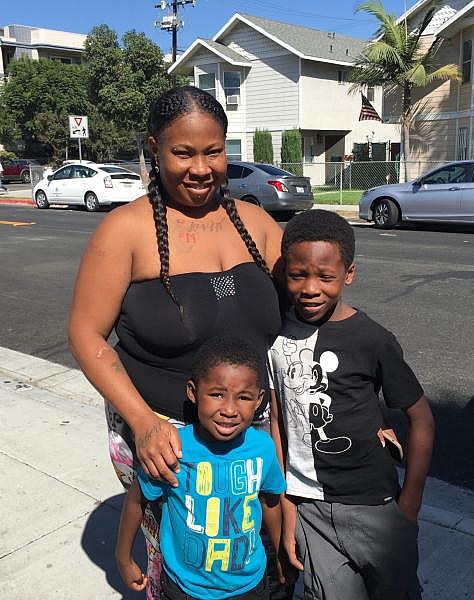California’s Home Visiting Program Aims to Help the Next Generation Rise from Inequality
This story is produced as part of a larger project by Claudia Boyd-Barrett, with the support of the Center for Health Journalism's Fund for Journalism on Child Well-Being.
Her other stories include:
Amid pandemic, young kids with special needs missing out on services
For Survivors of Violence and Their Kids, a Push to Prioritize Housing
Pandemic Pushes Parents of Kids With Special Needs to Breaking Point
Parents Caring for Children with Disabilities Have Some Advice

Photo by Warren Goldswain/iStock.
Marceda Harris could be forgiven for sometimes feeling overwhelmed.
The single mother from Long Beach is raising five children on her own, including one son with special needs and a rambunctious, inquisitive 5 year old. So it’s a welcome respite when, every couple of weeks, she and her children receive a visit from Sherida Harris.
“She comes in and we do activities together. She brings books to read and explains projects,” said Marceda Harris, who is not related to Sherida Harris. “She brings me coloring books to help me calm down so I have alone time, even if it’s just 10 minutes.”
Sherida Harris is a home visitor with SHIELDS for Families in South Los Angeles. The nonprofit group is among more than 50 community organizations, health care providers, school districts and other agencies in Los Angeles County that send trained professionals to the homes of pregnant women and parents of children up to age 5. These programs provide one-on-one outreach to parents who may be struggling to care for their children, often because of stressors such as poverty, or who simply want guidance on prenatal health and parenting. Home visitors coach parents on how to bond with their children, parent effectively and stimulate brain development. They also screen kids for health problems and developmental delays, and link parents to resources such as health care, employment training or counseling.
Research shows home visiting programs can help prevent child abuse and neglect, improve school readiness, increase physical and mental wellbeing of moms and kids, boost parents’ confidence in caring for their children, and result in greater economic self-sufficiency for families. They may also help reduce racial health disparities in breastfeeding and infant mortality, according to the California Budget and Policy Center. More than 85 percent of participants in several LA County home visiting programs are Black or Latinx. These families are more likely than white families to live in poverty, lack adequate health care, and suffer higher rates of infant death. Home visiting can help counter these inequalities, which arise from structural racism and economic disadvantage, program officials said.
Yet fewer than 2 percent of potentially eligible families statewide receive home visits, according to a report by the advocacy organization Children Now. That puts California behind more than 20 other states, including Oklahoma, Kansas and Missouri, according to data from the 2020 State of Babies Yearbook.
“There’s a big, big gap between the available programs and the need,” said Angela Rothermel, Children Now’s director of early childhood policy. “We want to get more of those supports out to families.”
Marceda Harris and her sons Jay’on and Tevin. Harris is enrolled in a home visiting program with SHIELDS for Families. Photo courtesy of Marceda Harris.
Part of the reason for the lag is that California did not directly invest in home visiting with state funds until 2018, resulting in a patchwork of local and federally funded programs that varied by county, said Rothermel. However, under Gov. Jerry Brown and now Gavin Newsom, California has committed almost $140 million in state-controlled money to home visiting, mainly for expectant parents and those with children under age 2 in the state’s welfare-to-work program, CalWORKS. Once fully implemented, around 18,500 families each year are expected to benefit from this funding.
The pace of that expansion has hit a speed bump, however, as Newsom and legislators wrestle a $54 billion budget deficit. A final budget agreement reached June 22 removes an additional $30 million that Newsom had proposed for home visiting in January, which would have extended the services to thousands more families. Legislators plan to reinstate that funding in the 2021 to 2022 fiscal year.
“We need to grow the system exponentially from where we are,” said Rothermel. “The pandemic just means it’s going to take more time.”
In Los Angeles County, home visiting programs serve almost 32,000 families through seven home visiting models, each with slightly different eligibility criteria and approaches, but with similar goals. The largest is Welcome Baby, launched and funded by First Five Los Angeles starting in 2009, and which reaches about 15,000 women who are pregnant or have babies up to 9 months old. Other models include Nurse-Family Partnership, Healthy Start, Parents as Teachers and Healthy Families America. These are nationwide programs adopted by agencies at the local level. Some serve families with children up to 5 years old. Parents sign up for the programs voluntarily and receive the services for free.
Like Marceda Harris and her children, most families enrolled in home visiting have very limited incomes. Many parents face additional stressors such as homelessness, have mental health issues or have children that have been put into foster care. These factors increase children’s risk for suffering toxic stress and trauma, which can result in lifelong problems including learning difficulties, and physical and mental health challenges. By intervening early, the goal of home visitors is to set families and children up for a healthier, more successful life.
“Home visiting is a prevention program,” said Jana Wright, coordinator of the Los Angeles County Perinatal and Early Childhood Home Visitation Consortium, a network of home visiting programs and providers. “The home visitor can display what healthy parenting looks like, how you should engage with your child to make sure you have those brain-building moments, to make sure your child has the best outcomes in life.”
Los Angeles County has one of the most robust home visiting networks in the state, said Wright. Even so, less than 4 percent of eligible families in the county receive home visiting services, the consortium found. Additional state funding to expand the programs to more families is necessary, she said, especially because tobacco taxes—which fund First Five commissions—have been gradually declining.
Investment in home visiting helps children who are facing the fallout from structural racism and income inequality, and reduces child welfare encounters, she said.
“It is not fair for communities and government to take away children when you provide no support for these families to do better for themselves,” Wright said. “In this state we have stated time and time again that our values are our children, and if that’s true that needs to be all of our children, not just the white children, not just the wealthy children.”
Qwanea Clemons of South Los Angeles is enrolled in a Parents as Teachers program through SHIELDS for Families. Since October, she’s been working with home visitor Kimberlyn Lundy, a former preschool teacher, on strengthening her relationships with her two daughters, ages 2 and 4. The girls were put into foster care because of domestic violence in the home. Clemons left the violent relationship and is now working on getting her daughters back. Lundy has helped Clemons navigate the court system and stay on track with requirements for regaining custody.
The children currently stay with Clemons four nights a week. Lundy guided her on how to plan for their visits, engage her daughters in constructive activities, and deal positively with challenging behavior. Clemons said she used to be distracted as a parent. Now she plays, dances and sings with her kids, and if they’re watching TV she watches with them.
“I’m just more involved,” she said. “They’re happy when they come home. They’re happy to see me.”
For Marceda Harris, who is also in the Parents as Teachers program, having a home visitor has helped her learn how to be more patient with her children, especially her 5 year old son. She’s learned simple games she can play with her kids, like “tennis” using balloons and paper plates, she said. Her home visitor also helped her find a new apartment after the place she was living in flooded, and to get a job as a nursing assistant after more than a year of being unemployed.
“I’m very excited,” said Marceda Harris. “I’ve been wanting to work for a long time.”
Home visitors have had to adapt during the pandemic and are reaching out to their families over the phone and through video chat, said Ava Moten, program manager for Parents as Teachers at SHIELDS for Families. They’ve found that families need even more support than in the past. Many parents are struggling with job losses, stress, uncertainty and disruption to their family’s routines. Some don’t have enough food for their children now that they’re home all day and not getting meals at school.
Home visitors have delivered groceries and diapers, connected parents to food banks and mental health support, and helped moms manage stress and set routines for their children, Moten said.
“Before, I knew home visiting was important,” she said. “With COVID-19 I have really seen how essential it is.”
Claudia Boyd-Barrett reported this story with the support of the Fund for Journalism on Child Well-Being, a program of the USC Annenberg Center for Health Journalism.
[This story was originally published by California Health Report.]

